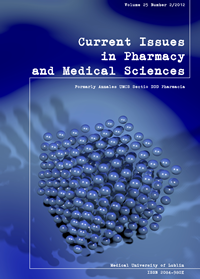Influence of astemizole, an H1 receptor antagonist, on the locomotors activity of carbamazepine and valproate in mice
DOI:
https://doi.org/10.12923/j.2084-980X/25.2/a.13Keywords:
exploratory locomotor activity, spontaneous locomotor activity, antiepileptic drugs, astemizole, adverse-effect profileAbstract
In the present study, we examined the influence of the second generation H1 receptor antagonist, astemizole, co-administered with carbamazepine and valproate on the exploratory and spontaneous activities in mice. Locomotor activity was monitored electronically using a Digiscan system with relation to the ambulatory and rearing activities, as well as, total distance traveled by animals within two 15-min periods. Results indicated that astemizole given alone did not affect on the three variable of motor activity, i.e. horizontal activity, total distance or vertical activity in mice. However, this H1 receptor antagonist significantly worsened horizontal and vertical activity of mice when was co-administered with valproate or carbamazepine in exploratory time. Moreover, it decreased total distance in combination with carbamazepine evaluated in spontaneous time. Our data clearly indicated that even newer generation of histamine receptor antagonists should be used with caution in patients suffering on epilepsy. It should be stressed that combined treatment of astemizole with carbamazepine or valproate may be clinically hazardous.
References
1. Churchull J.A., Gammon G.D.: The effect of antihistaminic drugs on convulsive seizures. J. Am. Med. Assoc., 141, 18, 1949.
2. Estes KS, González MA.: Pharmacokinetic aspects of second-generation H1 antihistamines: a reply to Philpot. Int J Clin Pharmacol Ther., 37,:310, 1999.
3. Fairbairn S., Sturman G.: The influence of central histaminergic modification on the susceptibility of mice to chemically-induced seizures [abstract]. Br. J. Pharmacol., 1989, 97, supl. 317.
4. Gerald, M.C., Richter, N.A.: Studies on the effects of histaminergic agents on seizure susceptibility in mice. Psychopharmacologia 46, 277, 1976.
5. Onodera, K., Watanabe, T., 1995. Possible roles of brain histamine H3 receptors and the pharmacology of its ligands. Nihon Shinkei Seishin Yakurigaku Zasshi 15, 87-102.
6. Scherkl R., Hashem A., Frey H.: Histamine in brain – its role in regulation of seizure susceptibility. Epilepsy Res. 10, 111, 1991.
7. Schwartz JC et al.: Histaminergic transmission in the mammalian brain. Physiol Rev., 71, 1, 1991.
8. Świąder M. et al.: Influence of antazoline on the anticonvulsant activity of conventional antiepileptic drugs against maximal electroshock-induced seizures in mice. Pol. J. Pharmacol., 51, 104, 1999.
9. Świąder M et al.: Influence of chronic treatment with H1 receptor antagonists on the anticonvulsant activity of antiepileptic drugs. Pol. J. Pharmacol., 53, 93, 2001.
10. Świąder M et al.: Interaction of astemizole, an H1 receptor antagonist, with conventional antiepileptic drugs in mice. Pharmacol. Biochem. Behav., 76, 169, 2003.
11. Świąder M et al.: Influence of antazoline and ketotifen on the anticonvulsant activity of conventional antiepileptics against maximal electroshock in mice. Eur. Neuropsychopharmacol., 14, 307, 2004.
12. Świąder MJ et al.: Effect of histamine receptor antagonists on aminophylline-induced seizures and lethality in mice. Pharmacol. Rep., 57, 531, 2005.
13. Tuomisto L., Tacke U.: Is histamine an anticonvulsive inhibitor transmitter. Neuropharmacology, 25, 955, 1986.
14. Wada H.et al.: Is the histaminergic neurons system a regulatory center for whole-brain activity? Trends Neurosci., 14, 415, 1991.
15. Wyngarden J. B., Seevers M. H.: The toxic effects of antihistaminic drugs. J. Am. Med. Assoc., 145, 277, 1951.
Downloads
Published
Issue
Section
License
Copyright (c) 2012 Authors

This work is licensed under a Creative Commons Attribution-NonCommercial-NoDerivatives 3.0 Unported License.


